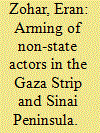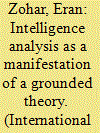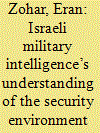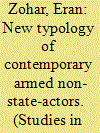|
|
|
Sort Order |
|
|
|
Items / Page
|
|
|
|
|
|
|
| Srl | Item |
| 1 |
ID:
139991


|
|
|
|
|
| Summary/Abstract |
Rebellious non-state actors of the Gaza Strip and the Sinai Peninsula have been arming themselves through smuggling networks operating in north-east Africa and the Middle East. They feature complex, dynamic, open systems which include many components of various organisational and national identities, and which are driven by various motives, united in order to accomplish the goal of arms smuggling. Previously, this system was dominated by the supply of Iranian large and high-quality weapon systems, mainly rockets, to the Palestinian Hamas, enabling them to build up military force that has sustained long-standing conflict against the stronger Israel. The Arab turmoil initiated dramatic changes in the arming system: Iran stopped, at least temporarily, the channelling of weapons to the Hamas due to its support of the Syrian opposition against the Assad regime. Egypt blocked many of Hamas's smuggling tunnels, intensifying Hamas's strategic isolation. Following the removal of Gaddafi and lack of government, Libya became a major arms source, serving mainly regional radical Islamic groups. Salafist jihadist groups in Sinai revolted against the Egyptian government, using huge local stockpiles of weapons and operational cooperation with Palestinian Islamists. This article argues that to survive, rebellious non-state actors must exploit arming opportunities in the physical, social and political environment, whereas securing shared borders is vital for defeating rebellious non-state actors. The arming of non-state actors should be analysed broadly, considering the needs of the civilian population among whom the militants are operating.
|
|
|
|
|
|
|
|
|
|
|
|
|
|
|
|
| 2 |
ID:
119423


|
|
|
|
|
| Publication |
2013.
|
| Summary/Abstract |
The often voiced criticism in academic and intelligence circles is that intelligence analysis lacks a structured methodology and relies on the intuition, impressions, and insights of analysts. In making these criticisms, the International Relations academic discipline attempts to credit itself with intelligence analysis while ascribing the failures of the United States Intelligence Community (IC) to the realm of intelligence analysis. Yet adopting models from other disciplines and launching "a revolution" in the thinking and methodologies of intelligence analysis is unnecessary. Intelligence analysis, particularly the basic kind, benefits from a rich and well-founded methodology that has emerged from analytic ranks.
|
|
|
|
|
|
|
|
|
|
|
|
|
|
|
|
| 3 |
ID:
141783


|
|
|
|
|
| Summary/Abstract |
The Arab Awakening was a strategic surprise for the Israeli military intelligence (AMAN), but did not cause immediate damage for the security of Israel because of the internal character of events. At an early stage AMAN recognized the general direction of the upheavals, which were more conflicts rather than the establishment of a democratic new order in the Middle East. The Arab Awakening operated as an intervening factor, escalating some of Israel’s major security challenges and de-escalating others. AMAN provided strategic intelligence warnings (of Iran’s military nuclear plan) and actionable intelligence (about Hezbollah’s infrastructure across the Syrian border), but presumed to assess the stability of regimes in a chaotic environment (Egypt, Syria), faced difficulties in monitoring capabilities of new actors (ISIS) and intentions of adversaries (Hamas). Fighting Hamas and Hezbollah, AMAN might subordinate itself to the strategy of deterrence rather than defeating the enemy. AMAN’s chiefs viewed the Arab Awakening as a facilitator to implement an unbalanced intelligence concept focusing on “shaping reality”, undermining the strategic analysis that must remain central to intelligence work.
|
|
|
|
|
|
|
|
|
|
|
|
|
|
|
|
| 4 |
ID:
144881


|
|
|
|
|
| Summary/Abstract |
This study analyzes contemporary non-state-actors (NSAs) finding four major categories: secessionist organizations fighting for a federal regime or full independence. These have a homogenous character and are domestically oriented. Secessionist NSAs that enjoy strong sponsorship are running a state within a state, possessing regular forces. Second, radical left revolutionary NSAs are fighting to overthrow the existing social order and to relocate power within a country. Arming with limited weaponry that they steal and purchase, they wage guerrilla war from dense jungles and rough mountains. Sectarian-based revolutionary NSAs seek regime change to stop state marginalization. They could evolve into a regular force, armed with heavy weapons. The fourth category and the most powerful is the global revolutionary organizations. They are religious based, seeking to impose Islamic rule in their own countries or worldwide through jihad. They are transnational, specializing in suicide bombing and sophisticated martyrdom assaults.
|
|
|
|
|
|
|
|
|
|
|
|
|
|
|
|
|
|
|
|
|